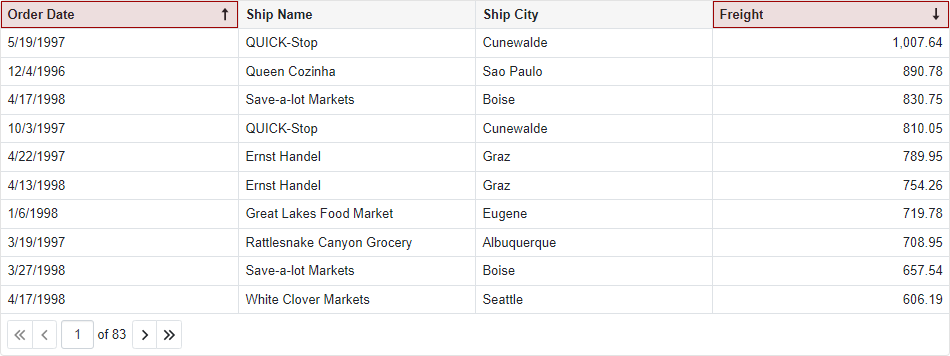DxGridDataColumn.AllowSort Property
Specifies whether users can sort data by the current column.
Namespace : DevExpress.Blazor
Assembly :
DevExpress.Blazor.v25.2.dll
NuGet Package :
DevExpress.Blazor
Declaration
[DefaultValue(null)]
[Parameter]
public bool? AllowSort { get; set; }Property Value
Type
Default
Description
Nullable <Boolean >null true to allow users to sort column data; otherwise, false.
The component allows users to sort data as follows:
Click a column header to sort data in ascending order and clear sort criteria for all other columns. Subsequent clicks reverse the sort order. The sort glyph indicates the column’s current sort order.
Hold Shift and click column headers to sort data by multiple columns.
Hold Ctrl and click a column header to clear sorting by this column.
Users can focus a column header and press Space , Shift +Space , or Ctrl +Space to change sort settings. Refer to the following topic for more information on keyboard shortcuts: Keyboard Support in Blazor Grid .
Set the Grid’s AllowSort property to false to prevent users from sorting grid data. The column’s AllowSort property allows you to specify whether users can sort grid data by this column. Note that the value specified at the column level overrides that of the component level.
Note
You can use the column’s SortIndex property and SortBy method to sort data in code regardless of the AllowSort property value.
The following code snippet prevents users from sorting grid data in the Ship Name column:
@using Microsoft.EntityFrameworkCore
@inject IDbContextFactory<NorthwindContext> NorthwindContextFactory
@implements IDisposable
<DxGrid Data="GridDataSource">
<Columns>
<DxGridDataColumn FieldName="OrderDate"
DisplayFormat="d" />
<DxGridDataColumn FieldName="ShipName"
AllowSort="false"/>
<DxGridDataColumn FieldName="ShipCity" />
<DxGridDataColumn FieldName="Freight"
DisplayFormat="n2" />
</Columns>
</DxGrid>
@code {
object GridDataSource { get; set; }
NorthwindContext Northwind { get; set; }
protected override void OnInitialized() {
Northwind = NorthwindContextFactory.CreateDbContext();
GridDataSource = Northwind.Orders.ToList();
}
public void Dispose() {
Northwind?.Dispose();
}
}
using System;
using System.Collections.Generic;
#nullable disable
namespace Grid.Northwind {
public partial class Order {
public Order() {
OrderDetails = new HashSet<OrderDetail>();
}
public int OrderId { get; set; }
public string CustomerId { get; set; }
public int? EmployeeId { get; set; }
public DateTime? OrderDate { get; set; }
public DateTime? RequiredDate { get; set; }
public DateTime? ShippedDate { get; set; }
public int? ShipVia { get; set; }
public decimal? Freight { get; set; }
public string ShipName { get; set; }
public string ShipAddress { get; set; }
public string ShipCity { get; set; }
public string ShipRegion { get; set; }
public string ShipPostalCode { get; set; }
public string ShipCountry { get; set; }
public virtual Customer Customer { get; set; }
public virtual Shipper ShipViaNavigation { get; set; }
public virtual ICollection<OrderDetail> OrderDetails { get; set; }
}
}
using Microsoft.EntityFrameworkCore;
#nullable disable
namespace Grid.Northwind {
public partial class NorthwindContext : DbContext {
public NorthwindContext(DbContextOptions<NorthwindContext> options)
: base(options) {
}
// ...
public virtual DbSet<Order> Orders { get; set; }
// ...
protected override void OnConfiguring(DbContextOptionsBuilder optionsBuilder) {
if(!optionsBuilder.IsConfigured) {
optionsBuilder.UseSqlServer("Server=.\\sqlexpress;Database=Northwind;Integrated Security=true");
}
}
protected override void OnModelCreating(ModelBuilder modelBuilder) {
modelBuilder.HasAnnotation("Relational:Collation", "SQL_Latin1_General_CP1_CI_AS");
// ...
modelBuilder.Entity<Order>(entity => {
entity.HasIndex(e => e.CustomerId, "CustomerID");
entity.HasIndex(e => e.CustomerId, "CustomersOrders");
entity.HasIndex(e => e.EmployeeId, "EmployeeID");
entity.HasIndex(e => e.EmployeeId, "EmployeesOrders");
entity.HasIndex(e => e.OrderDate, "OrderDate");
entity.HasIndex(e => e.ShipPostalCode, "ShipPostalCode");
entity.HasIndex(e => e.ShippedDate, "ShippedDate");
entity.HasIndex(e => e.ShipVia, "ShippersOrders");
entity.Property(e => e.OrderId).HasColumnName("OrderID");
entity.Property(e => e.CustomerId)
.HasMaxLength(5)
.HasColumnName("CustomerID")
.IsFixedLength(true);
entity.Property(e => e.EmployeeId).HasColumnName("EmployeeID");
entity.Property(e => e.Freight)
.HasColumnType("money")
.HasDefaultValueSql("((0))");
entity.Property(e => e.OrderDate).HasColumnType("datetime");
entity.Property(e => e.RequiredDate).HasColumnType("datetime");
entity.Property(e => e.ShipAddress).HasMaxLength(60);
entity.Property(e => e.ShipCity).HasMaxLength(15);
entity.Property(e => e.ShipCountry).HasMaxLength(15);
entity.Property(e => e.ShipName).HasMaxLength(40);
entity.Property(e => e.ShipPostalCode).HasMaxLength(10);
entity.Property(e => e.ShipRegion).HasMaxLength(15);
entity.Property(e => e.ShippedDate).HasColumnType("datetime");
entity.HasOne(d => d.Customer)
.WithMany(p => p.Orders)
.HasForeignKey(d => d.CustomerId)
.HasConstraintName("FK_Orders_Customers");
entity.HasOne(d => d.ShipViaNavigation)
.WithMany(p => p.Orders)
.HasForeignKey(d => d.ShipVia)
.HasConstraintName("FK_Orders_Shippers");
});
// ...
OnModelCreatingPartial(modelBuilder);
}
partial void OnModelCreatingPartial(ModelBuilder modelBuilder);
}
}
using Microsoft.EntityFrameworkCore;
// ...
builder.Services.AddDbContextFactory<NorthwindContext>((sp, options) => {
var env = sp.GetRequiredService<IWebHostEnvironment>();
var dbPath = Path.Combine(env.ContentRootPath, "Northwind-5e44b51f.mdf");
options.UseSqlServer("Server=(localdb)\\MSSQLLocalDB;Integrated Security=true;AttachDbFileName=" + dbPath);
});
Run Demo: Grid - Sort Data
VIDEO
View Example: Grid - Custom Sorting
For more information about data sorting in the Grid component, refer to the following topic: Sort Data in Blazor Grid .
See Also
